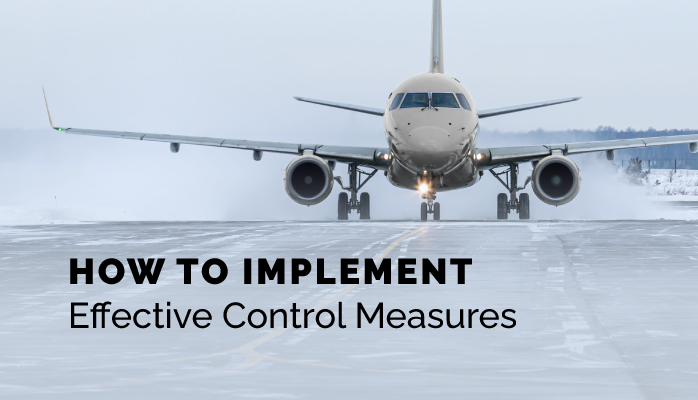What Are Control Measures?

When you identify a hazard within your organization, the first step is to analyze the risk. If the risk is high, then you need a control measure to reduce risk to acceptable levels.
Any change made to the existing system to reduce risk is a control measure.
Control measures can be simple or complex. Using a less hazardous chemical might be a simple control. Designing and installing a new ventilation system would be more complicated.
The controls your team implements will depend on risk and available resources.
How to Select Control Measures
A helpful tool in selecting control measures is the hierarchy of hazard controls. There are several of these hierarchies available, but the most common are:
- Elimination
- Substitution
- Engineering Controls
- Administrative Controls
- PPE
Elimination of the hazard is the most effective control measure, and it's easy to see why. If you remove a hazard, its risk of harm drops to zero. For example, if you move high equipment to the ground before working on it, you eliminate the risk of a fall.
The second most effective control is substitution. Ask yourself if there is a substitution that carries less risk. For example, deet is an effective ingredient in bug spray, but it's hazardous to humans. If we switch our bug spray for one that has less deet, we are reducing but not eliminating our risk.
Engineering controls place a barrier between the hazard and people. For example, a ventilation system keeps fumes from reaching workers. The fumes are still hazardous, but the ventilation system vents them to a safe place.
Administrative controls are changes made to the processes and procedures to limit exposure. This could include training, signs, or warning labels. These controls rely on human memory, checklists, awareness, and compliance.
PPE, or Personal Protective Equipment, is at the bottom of the hierarchy. Most of us are familiar with PPE; gardening gloves, safety glasses, and breathing masks are all common examples. PPE relies on training and proper usage to be effective.
Related Articles on Control Measures in Aviation SMS
- How to Monitor the Effectiveness of Control Measures
- How to Define Acceptable Level of Safety (ALoS) in Aviation SMS
- Acceptable Level of Safety (ALoS) in Aviation SMS
What Makes Control Measures Effective
Control measures should reduce risk as low as reasonably practicable (ALARP). Notice that the word is practicable and not possible.
For example, airplanes would never crash if they were never flown. It is possible to never fly. If flying is your business, then never flying isn't a practicable solution.
To check that risk is ALARP, perform a risk assessment with the proposed control measure in place. This will identify any residual risk. Does the control measure lower the risk to a level you’re willing to accept?
If the residual risk is unacceptable, examine your control measures. Is there a more effective control measure you could use? Can you put another control measure in place? Sometimes you need more than one control measure to reduce the risk to ALARP.
How to Measure Success
Once you have chosen control measures, it's important to measure their success. To achieve this, your team will establish safety performance indicators or SPIs. Some purists call SPIs "key performance indicators" or "KPIs." SPIs quantify the efficacy of your control measures.
When choosing SPIs, always make them specific and measurable. Reducing employee exposure to jet fuel may be the goal of your control measure, but it isn’t measurable. A good SPI might be to: reduce incidents of exposure by 50% over the next six months.
Once you’ve selected your SPIs, make sure that you track them. Depending on your SPIs, this may be data your system already collects, or you may have to set up a new way to gather it.
Related Articles on How to Measure Success in Aviation SMS
- 9 Success Tips for Aviation SMS Consultants
- What Is Success in Aviation Risk Management?
- What Is the Key to Successful Risk Management?
Adjusting Control Measures
The data collected by your SPIs feeds a continuous process. If your control measure achieves the desired effect, you can congratulate yourself. If it doesn't work as well as you hoped, you can reevaluate and adjust.
It can be discouraging to go back to the drawing board. After all, reevaluation takes valuable time and effort. This time and effort will pay off in the long run.
As Thomas Edison said about the creation of the light bulb, “I have not failed. I've just found 10,000 ways that won't work.”
Hopefully, you don't need to test 10,000 control measures before finding the right one.
Learning More About Control Measures
Nearly every industry uses control measures to improve safety and manage risk. Many of the resources available do not focus on aviation, but they still hold value.
Resources created for other fields show how those industries craft control measures. Studying their solutions can help us create more effective control measures.
Meanwhile, putting your control measures to the test creates new information every day. Record those experiences and pass them on. By doing so, you contribute to the knowledge of the aviation industry as a whole.
What have you learned about creating effective control measures? Share them in the comments below and pay them forward to a new generation of safety managers.
Last updated in January 2025.






